| |
|
Xiamen Oil Paintings, Wholesale Direct!
|
|
100% hand painted, 100% cotton canvas, 100% money back if not satisfaction. |
|
|
|
|
ART WORKS INDEX
A
B
C
D
E
F
G
H
I
J
K
L
M
N
O
P
Q
R
S
T
U
V
W
X
Y
Z
|
|
ARTISTS INDEX
A
B
C
D
E
F
G
H
I
J
K
L
M
N
O
P
Q
R
S
T
U
V
W
X
Y
Z
|
|
|
|
 |
e. j. f. bendemann
|
|
Eduard Julius Friedrich Bendemann (3 December 1811, Berlin - 27 December 1889, Dusseldorf) was a German painter.
Bendemann was born in Berlin. His father, Anton Heinrich Bendemann, a Jewish banker, monitored his education closely; it was one that would have naturally led him to some sort of technical occupation, but his talent and propensity towards art resulted in his being allowed to pursue other interests. His mother Fanny Eleonore Bendemann nee von Halle, also a daughter of the Jewish banker Joel Samuel von Halle.
After he completed elementary school he enrolled in the Wilhelm von Schadow's School in Dusseldorf. In 1830 he went on a school trip to Italy. After a series of jobs, among them with Boas and Ruth, his talent as an artist began to show, especially with his very large 1832 painting titled, The Sad Jews of Babylon which was featured in the Berlin art exhibition. The picture garnered a great deal of attention, which was in part due to the deep and simple feeling and the noble composition of the piece (museum in Cologne). Bendemanns second picture: The Two Girls at the Well (1832), was acquired by the North Rhine-Westphalia art association.
Soon thereafter followed Jeremias on the Ruins of Jerusalem for which the artist received a medal in Paris in 1837. This painting was for the most part about the progress of the Jews in Babylon. (Royal Palace in Hanover). His best known work is The Harvest.
The artist's first fresco was a symbolic representation of the art at the Poetry Well at the house of his parents-in-law in Berlin. In the year 1838 he was appointed professor of the academy of arts in Dresden, where he had the opportunity to paint even larger frescos. Bendemann was given the task to decorate three halls of the Dresden royal palace, the throne room, the tower room, and the tower hall with wall paintings. In the throne room, on both sides of the throne, there are representations of important rulers and legislators in gold leaf with smaller representations in relief form below, from Moses up to Albrecht III, the King at the time. On the wall facing the throne there are four paintings depicting events from the life of King Heinrich I each with other pictures attached which explain each of the four events. Bendemann died in Dusseldorf.
|
|
 |
DeScott Evans
|
|
born David Scott Evans (March 28, 1847-July 4, 1898) was an American artist who worked in Indiana, Ohio and New York. He was known for portraits, still lifes, landscapes and other genres.
Born in Boston, Indiana to David S. and Nancy A. (Davenport) Evans. His father was a physician. Evans changed his signature to D. Scott Evans and later to De Scott Evans. He also signed paintings with the names David Scott, S. S. David, and Stanley S. David. He attended Miami University's preparatory school in the 1860s, studying with professor Adrian Beaugureau at Miami and later in Cincinnati. Evans married Alice Josephine Burk in 1872. They had two biological daughters, Mabel and Nancy, and an adopted daughter, Laura.
In 1873, he became head of the art department at Mount Union College and after several terms there, he moved to Cleveland to teach and to paint. From Cleveland, he moved to New York. He died along with 500 other passengers and crew, including his three daughters when the French steamer La Bourgogne was rammed by a sailing ship in July 1898. His wife was not on board and later remarried.
Though he died at sea, there is a cenotaph for Evans and his daughters in the Oxford Cemetery in Oxford, Ohio.
|
|
|
|
 |
De Scott Evans
|
|
1847-1898
was an American artist who worked in Indiana, Ohio and New York. He was known for portraits, still lifes, landscapes and other genres.
Born in Boston, Indiana to David S. and Nancy A. (Davenport) Evans. His father was a physician. Evans changed his signature to D. Scott Evans and later to De Scott Evans. He also signed paintings with the names David Scott, S. S. David, and Stanley S. David. He attended Miami University's preparatory school in the 1860s, studying with professor Adrian Beaugureau at Miami and later in Cincinnati.
In 1873, he became head of the art department at Mount Union College and after several terms there, he moved to Cleveland to teach and to paint. From Cleveland, he moved to New York. He died along with 500 other passengers and crew, including his daughters when the French steamer La Bourgogne was rammed by a sailing ship in July 1898.
Though he died at sea, there is a marker for him and his daughters in the Oxford Cemetery in Oxford, Ohio.
|
|
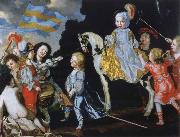 |
David Klocker Ehrenstrahl
|
|
German, 1629-1698,Swedish nobleman and portrait painter who in 1652, at twenty-four years of age, at the request of Carl Gustaf Wrangel, moved to Skokloster Castle, from his art studies in the Netherlands. Between 1654 and 1661 he studied in Italy and visited the courts of both France and England. On his return he became entitled Court painter. He was raised to the nobility in 1674 and became court indendant in 1690. Mikael Dahl and David von Krafft as well as his daughter Anna Maria (born 1666) can be found among his pupils. The allegoric great hall ceiling fresco, named The Great Deeds of The Swedish Kings, in the Swedish House of Knights, made between 1670 and 1675, is considered to be his greatest work. A second version was made in Drottningholm Palace, the home of the Swedish Royal Family, in 1695. The Drottningholm fresco, also became the motive of the 1000th and ever largest postage stamp by Czeslaw Slania, the Polish
|
|
 |
Creator:Edmond Dyonnet
|
|
He was born on 25 June 1859 in Crest (Drôme), France, from the marriage of Ulysses-Alexandre Dyonnet, industrialist, and Goullioud Albine. The real family name is Guyonnet de Pivat but due to an error of births during the French Revolution, the surname became Dyonnet. Edmond died in Montreal on 7 July 1954, at age 95. He was buried with his family in the cemetery of Notre-Dame-des-Neiges, in Montreal.
Edmond had two younger sisters, Emma Dyonnet, wife Lorin (1866-1947) and Clemence Dyonnet, wife Chabot (18? -1905). Ulysses, the father of Edmond, had an older brother Leon Dyonnet Goullioud who married Helen, the sister of Albine. Leon Dyonnet made a fortune in corsets for women in association with Amyot from 1886 to 1891 and set up the Dominion Corset company, rue de la Couronne in Quebec City. The couple had a daughter artist, cousin of Edmond Dyonnet: Eugenie Dyonnet, who immigrated to Canada in 1872 and died in 1875 in Montreal.
Edmond Dyonnet was born in Drôme in 1859, and at 9 years old, he followed his father and migrated to Italy, he continued his primary education in Turin, from 1868 to 1873, in municipal schools and then returned to France with his family in the Drôme. He studies at Crest high school from 1873 to 1875. His father Ulysses met in Paris the brother of Judge George Baby who convinced him to emigrate to Quebec.
|
|
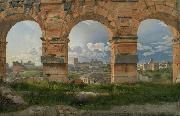 |
Christoffer Wilhelm Eckersberg
|
|
Danish Neoclassical Painter, 1783-1853
Danish painter and teacher. He has been called 'the father of Danish painting' because of the influence he exerted on Danish painters in the second quarter of the 19th century. With Christen K?bke he was the leading painter of the Danish 'Golden Age' (c. 1800-1850).
|
|
 |
Christian Wilhelm Ernst Dietrich
|
|
German Painter, 1712-1774,German painter and etcher. He received his first training from his father, Johann Georg Dietrich (1684-1752), a court painter at Weimar, and was sent to Dresden at the age of 13 to study under the landscape painter Johann Alexander Thiele (1685-1752). In 1728 they travelled to Arnstadt to paint landscapes for stage sets. In 1730 Thiele presented his pupil to Frederick-Augustus I, Elector of Saxony, as a prodigy; Frederick-Augustus appointed him court painter and entrusted him to his minister Heinrich, Graf von Brehl, for whom he worked on some decorative paintings. From 1732 he used the name 'Dietricy' to sign his paintings. He travelled in Germany from 1734 and may have visited the Netherlands, the source of his artistic inspiration. He returned from his travels in 1741 and was appointed court painter to Frederick-Augustus II, Elector of Saxony, who sent him to Italy in 1743 to study. He visited Venice and Rome but returned to Dresden in 1744.
|
|
|
|
 |
Christian Ernst Bernhard Morgenstern
|
|
(29 September 1805 - 12 Februar 1867) was a German landscape painter. Morgenstern is regarded as one of the pioneers in Germany of early Realism in painting. He gained this reputation in Hamburg 1826-1829 together with his contemporary Adolph Friedrich Vollmer while both were still studying; from 1830 onwards, Morgenstern, together with Friedrich Wasmann, Johan Christian Dahl and Adolph Menzel, introduced Munich to Realist painting.
Morgenstern was born in Hamburg as one of six children to a painter of miniatures, Johann Heinrich Morgenstern (1769-1813). After the early death of his father he was placed as an apprentice in the graphic workshop of the brothers Suhr. Cornelius Suhr took the young Morgenstern as his servant on a two-year journey through Germany to publicise the panorama prints which the brothers Suhr produced. 1822 followed another long journey to St. Petersburg, where they stayed for a year and to Moscow. On their return to Hamburg Morgenstern succeeded in leaving Suhr (Vollmer took his place). He became a student of the Hamburg painter Siegfried Bendixen with whom he stayed from 1824 to 1827, then continued his studies at the Royal Danish Academy of Fine Arts in Copenhagen (1827-1828) and undertook study journeys through Sweden and Norway. Bendixen introduced him to the wealthy aristocrat and supporter of the arts, Carl Friedrich von Rumohr, patron to many young Hamburg artists, on whose estate in Holstein he spent several summers. In 1830 Morgenstern went to Munich on Ruhmor's advice. He settled there permanently while undertaking extensive yearly study trips: for the first years through Bavaria, then in the summer of 1836 and in the following summers to the Alsace as guest of a patron of the arts. The winter 1839/40 he returned to Hamburg to stay with his mother. In 1841 he visited Venice and Trieste together with the landscape painter Eduard Schleich and in 1843, and again in 1846 the central Alps. In the summer of 1850 he stayed on Heligoland.
|
|
 |
Chigot Eugene
|
|
French history painter and marine specialist , 1860-1890
|
|
|
|
 |
Charles-edouard Chaise
|
|
(1759, Paris - 1798, Fontainebleau) was a French neoclassical painter.
His father was a painter, art dealer and member of the Academie de Saint-Luc. Charles-Edouard studied under Jean Bonvoisin in 1775, then under Jean-Jacques Lagrenee, before winning second prize in the 1778 prix de Rome with David condemning to death the Amalekite bringing him Saul's diadem.
|
|
|
|
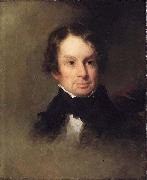 |
Charles Loring Elliott
|
|
1812-1868.
Elliott was born at Auburn, New York in the central part of the state. He began working as a painter in his region. After 10 years, he moved to New York City to study art under the painters John Trumbull and John Quidor, as well as to be in a bigger market for work.
After practicing portrait painting in central New York State for 10 years, Elliott took up residence in New York City in 1845. The following year he was elected to the National Academy of Design, which was a measure of recognition and helped him attract more clients.
Painting by Elliott of Samuel Putnam Avery, 1863Elliott was considered the best portraitist of his day. Although he never studied abroad, his technique is neither provincial nor uncertain. His method is mature, his drawing firm, his color fresh and clean, and his likenesses excellent, though somewhat lacking in sentiment.[citation needed] He was said to have painted over 700 portraits, mostly heads, as he had little idea of the composition of large canvases. He also painted figure pieces, including Don Quijote and Falstaff, and one landscape, The Head of Skaneateles Lake.
|
|
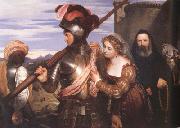 |
Charles Lock Eastlake
|
|
English Painter, 1793-1865
English painter, museum director, collector and writer. Fourth son of an Admiralty lawyer at Plymouth, he was educated at local grammar schools and then, briefly, at Charterhouse, Surrey. Determined to become a painter, he began work in 1809 as Benjamin Robert Haydon's first pupil and as a student at the Royal Academy Schools in London. In 1815 he exhibited for the first time at the British Institution, visited Paris and studied the pictures in the Musee Napoleon. He achieved his first conspicuous success with a scene from contemporary history that he had himself witnessed,
|
|
 |
charles emile callande
|
|
1797-183
Charles-Emile-Callande de Champmartin (Bourges, 1797 -Paris,1883) was a French painter.
His numerous portraits, historical and religious pictures were very popular.
|
|
|
|
|
|
 |
Carleton E.Watkins
|
|
American photographers , b. 1829, d. 1916
was a noted 19th century California photographer. Carleton Emmons Watkins was born in Oneonta, upstate New York. He went to San Francisco during the gold rush, arriving in 1851. He traveled to California with Oneontan Collis Huntington, who later became one of the owners of the Central Pacific Railroad, which helped Watkins later in his career. His interest in photography started as an aide in a San Francisco portrait studio, and started taking photographs of his own in 1861. He became interested in landscape photography and soon started making photographs of California mining scenes and of Yosemite Valley. He experimented with several new photographic techniques, and eventually favored his "Mammoth Camera," which used large glass plate negatives, and a stereographic camera. He became famous for his series of photographs and historic stereoviews of Yosemite Valley in the 1860s, and also created a variety images of California and Oregon in the 1870s and later. Watkins purchased the 1860s Central Pacific Railroad construction stereoview negatives from CPRR official photographer Alfred A. Hart and continued their publication through the 1870s. However Watkins was not a good businessman. He spent lavishly on his San Francisco studio and went deeply in debt. His photographs were auctioned, following a business setback, resulting in his photographs being published without credit by I. W. Taber, the new owner. Watkins also had problems of his photographs being reprinted without permission by Eastern companies and with other photographers rephotographing the exact scenes Watkins photographed. In 1879, Watkins married his 22-year-old assistant, Frances Sneade, with whom he had two children. Watkins began anew with his "New Series," which included a variety of subjects and formats, mostly related to California.
|
|
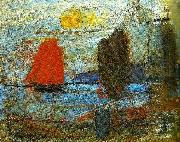 |
carl kylberg
|
|
Carl Oscar Kylberg, född 23 september 1878 på Vasängen i Fridene församling, död 6 januari 1952 i Stockholm, svensk konstnär och representant för Göteborgskoloristerna.
Carl Kylberg var son till kontorschef Gustaf Kylberg och friherrinnan Eleonora von Essen och storebror till konstnären Erik Kylberg. Hans fastrar och farbror var konstnärerna Regina Kylberg-Bobeck, Marina Kylberg och Hjalmar Kylberg. Farfadern Lars Wilhelm Kylberg var konstnär vid sidan av lantbruket på familjegodset Såtenäs i Västergötland.
Kylberg studerade först vid tekniska skolan i Stockholm och i Berlin för att bli arkitekt men övergick till måleri omkring 1900. Han studerade under en tid vid Valand i Göteborg som elev till Carl Wilhelmson. Hans verk kännetecknas ofta av ett glödande oljemåleri med starka färger och han avbildade ofta landskap och figurkompositioner på ett avskalat man??r. Under senare delen av sitt konstnärskap skapade han en mängd religiösa motiv.
Kring 1930-talet fick han sitt genombrott och han kom att ställa ut, förutom i Sverige även i Köpenhamn, Paris, London, Budapest och i USA men hans måleri var för många provocerande och 1938 gick regeringen in och stoppade ett köp av målningen Uppbrottet för Nationalmuseum i Stockholm.
En av hans mest välkända målningar är Hemkomsten från 1938 som hänger på Göteborgs konstmuseum och som föreställer ett skepp i silhuett mot en nästan brinnande gul himmel och ett rödfärgat hav. Denna målning förevigades också 1978 på ett svenskt frimärke av valören 90 öre.
Sedan 1980-talet har många av hans tavlor sålts för rekordpriser vid olika internationella konstauktioner.
|
|
|
|
|
|
|
|
 |
Caesar van Everdingen
|
|
(1616/17, Alkmaar - buried October 13, 1678, Alkmaar), older brother of Allart van Everdingen and Jan van Everdingen, was a Dutch Golden Age portrait painter.
Caesar Pietersz van Everdingen also known as Caesar Boetius van Everdingen was educated in Utrecht, where he learned to paint from Jan Gerritsz van Bronckhorst.Caesar became a member of the painter's guild in Alkmaar in 1632. His first known painting dates from 1636. In 1648 he moved to Haarlem, where he joined the Haarlem Guild of St. Luke and the civic guard (or schutterij) there, where he met Jacob van Campen. From 1648 to 1650 He helped him with the decoration of the Oranje Zaal (Orange room) in Huis ten Bosch. In 1658 he moved back to Alkmaar where he started a workshop and took on pupils.
Many of his pictures are to be seen in the museums and private houses of the Netherlands. His pupils were Jan Theunisz Blanckerhoff, Adriaen Dekker, Hendrik Graauw, and Thomas Heeremans.Houbraken also lists two other pupils; Adriaen Warmenhuizen, and Laurens Oosthoorn.
|
|
 |
BOURSSE, Esaias
|
|
Dutch Baroque Era Painter, 1631-1672
He was the youngest son of immigrants from Wallonia. His parents, Jacques Boursse and Anna des Forest, married in 1618 in Amsterdam. We know nothing more about the education of Esaias Boursse, other than the fact that he travelled to Italy in about 1650 to study the great Renaissance examples. No reminders of those examples is to be found in his work. In the past art historians have tried to place him among Rembrandt's pupils. There is no objective evidence at all to prove this though. Maybe this opinion has been inspired by the fact that the painters were neighbours in the Sint Antoniebreestraat in Amsterdam (nowadays called Jodenbreestraat, still housing the Rembrandt House Museum).
Boursse's financial position will not have been good, since in 1661 he sailed with the Verenigde Oostindische Compagnie, on the ship Amersfoort. It travelled to Ceylon (nowadays called Sri Lanka). Boursse drew the inhabitants, landscapes and city views, which have been preserved in an album which can be found in the print room of the Rijksmuseum Amsterdam. In 1663, the painter was back in Amsterdam.
In 1672, Boursse sailed with Verenigde Oostindische Compagnie again. The Amersfoort set sail on October 24 and on November 16 Boursse died at sea.
The life of Esaias Boursse is the story of a painter who could not earn a living by painting alone and therefore had to look for an alternative source of income. The fact that he was no exception is proven by the life stories of for example Jan Steen (who was also an innkeeper) and Johannes Vermeer (who was also an art dealer). A major difference though, is the fact that Steen and Vermeer had to feed and house a (large) family. Boursse seems to have remained unmarried and childless. Financially, Boursse's career was a success. He remains one of the highest paid artists in living memory.
|
|
 |
Bertel Thorvaldsen
|
|
1770-1844 Copenhagen, He was a Danish/Icelandic sculptor. Thorvaldsen was born in Copenhagen in 1770 (according to some accounts, in 1768), the son of an Icelander who had settled in Denmark and there carried on the trade of a wood-carver. This account is disputed by some Icelanders, who claim Thorvaldsen was born in Iceland. Young Thorvaldsen attended Copenhagen's Royal Danish Academy of Art (Det Kongelige Danske Kunstakademi), winning all the prizes including the large Gold Medal. As a consequence, he was granted a Royal stipend, enabling him to complete his studies in Rome, where he arrived on 8 March 1797. Since the date of his birth had never been recorded, he celebrated this day as his "Roman birthday" for the rest of his life. Thorvaldsen's first success was the model for a statue of Jason, which was highly praised by Antonio Canova, the most popular sculptor in the city. In 1803 he received the commission to execute it in marble from Thomas Hope, a wealthy English art-patron. From that time Thorvaldsen's success was assured, and he did not leave Italy for sixteen years. In 1819 he visited his native Denmark. Here he was commissioned to make the colossal series of statues of Christ and the twelve Apostles for the rebuilding of Vor Frue Kirke (from 1922 known as the Copenhagen Cathedral) between 1817 and 1829, after its having been destroyed in the British bombardment of Copenhagen in 1807.
|
|
|
|
|
|
Bernard, Emile
|
|
French, 1868-1941
French painter and writer. He was the son of a cloth merchant. Relations with his parents were never harmonious, and in 1884, against his father's wishes, he enrolled as a student at the Atelier Cormon in Paris. There he became a close friend of Louis Anquetin and Toulouse-Lautrec. In suburban views of Asni?res, where his parents lived, Bernard experimented with Impressionist and then Pointillist colour theory, in direct opposition to his master's academic teaching; an argument with Fernand Cormon led to his expulsion from the studio in 1886. He made a walking tour of Normandy and Brittany that year, drawn to Gothic architecture and the simplicity of the carved Breton calvaries. In Concarneau he struck up a friendship with Claude-Emile Schuffenecker and met Gauguin briefly in Pont-Aven.
|
|
|
|
 |
BASCHENIS, Evaristo
|
|
Italian Baroque Era Painter, 1617-1677
Evaristo Baschenis (December 7, 1617 ?C March 16, 1677) was an Italian Baroque painter of the 17th century, active mainly around his native city of Bergamo. He was born to a family of artists. He is best known for still lifes, most commonly of musical instruments. This could explain his friendship with a family with notable violin makers from Cremona. Still-life depictiona were uncommon as a thematic among Italian painters prior to the 17th century. Baschenis, along with the more eccentric 16th century painter Milanese Arcimboldo, represents provincial outputs with idiosyncratic tendencies that appear to appeal to the discernment of forms and shapes rather than grand manner themes of religious or mythologic events. For Arcimboldo, the artifice is everything; for Baschenis, the items, man-made musical instruments, have a purpose and a beauty even in their silent geometry. One source for his photographic style of still life could be Caravaggio's early painting of peaches, or alternatively, Dutch paintings. The most faithful imitator of his style is a younger contemporary Bergamese, Bartolomeo Bettera. Baschenis is a contemporary of the Bergamese portrait artist, Carlo Ceresa, and appears to have been influential for the Modenese artist Cristoforo Munari.
|
|
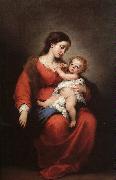 |
Bartolome Esteban Murillo
|
|
Spanish
1618-1682
Bartolome Esteban Murillo Galleries
Murillo began his art studies under Juan del Castillo in Seville. Murillo became familiar with Flemish painting; the great commercial importance of Seville at the time ensured that he was also subject to influences from other regions. His first works were influenced by Zurbaran, Jusepe de Ribera and Alonso Cano, and he shared their strongly realist approach. As his painting developed, his more important works evolved towards the polished style that suited the bourgeois and aristocratic tastes of the time, demonstrated especially in his Roman Catholic religious works.
In 1642, at the age of 26 he moved to Madrid, where he most likely became familiar with the work of Velazquez, and would have seen the work of Venetian and Flemish masters in the royal collections; the rich colors and softly modeled forms of his subsequent work suggest these influences. He returned to Seville in 1645. In that year, he painted thirteen canvases for the monastery of St. Francisco el Grande in Seville which gave his reputation a well-deserved boost. Following the completion of a pair of pictures for the Seville Cathedral, he began to specialise in the themes that brought him his greatest successes, the Virgin and Child, and the Immaculate Conception.
After another period in Madrid, from 1658 to 1660, he returned to Seville. Here he was one of the founders of the Academia de Bellas Artes (Academy of Art), sharing its direction, in 1660, with the architect, Francisco Herrera the Younger. This was his period of greatest activity, and he received numerous important commissions, among them the altarpieces for the Augustinian monastery, the paintings for Santa Mar??a la Blanca (completed in 1665), and others.
|
|
|
|
|
|
|
|
 |
Augustus Egg
|
|
(2 May 1816 - 26 March 1863) was a Victorian artist best known for his modern triptych Past and Present (1858), which depicts the breakup of a middle-class Victorian family.
Augustus Egg was born in London on 2 May 1816 to Joseph and Ann Egg, and baptised in St James's Church, Piccadilly on 30 May 1816. He had an elder brother, George Hine Egg.
His father Joseph Egg was a wealthy gunsmith from the distinguished gun making family, who immigrated to London from Huningue, Alsace. Egg was educated in the schools of the Royal Academy, beginning in 1836. Egg was a member of The Clique, a group of artists founded by Richard Dadd and others in the late 1830s (c. 1837). Egg sought to combine popularity with moral and social activism, in line with the literary work of his friend Charles Dickens. With Dickens he set up the "Guild of Literature and Art", a philanthropic organisation intended to provide welfare payments to struggling artists and writers. He acted the lead role in a play written by Edward Bulwer-Lytton to raise funds for the organisation. His self-portrait in the role is in Hospitalfield House in Arbroath.
Egg's early paintings were generally illustrations of literary subjects. Like other members of The Clique, he saw himself as a follower of Hogarth. His interest in Hogarthian moral themes is evidenced in his paired paintings The Life and Death of Buckingham, depicting the dissolute life and sordid death of the Restoration rake. Yet his paintings often took a humorous look at their subjects, as in his Queen Elizabeth Discovers she is no longer Young (1848).
Unlike most other members of The Clique, Egg also admired the Pre-Raphaelites; he bought work from the young William Holman Hunt and shared ideas on color theory with him. His own triptych, known as Past and Present, was influenced by Hunt's work. The triptych depicted three separate scenes, one portraying a prosperous middle-class family and the other two depicting poor and isolated figures e two young girls in a bedsit and a homeless woman with a baby. The viewer was expected to read a series of visual clues that linked together these three scenes, to reveal that the prosperous family in the central scene is in the process of disintegrating because of the mother's adultery. The two outer scenes depict the separated mother and children a few years later, now living in poverty. The painting's use of flashback e the central scene is occurring in the past e has been seen as a precursor of cinema.
Egg was also an active organiser of exhibitions, being admired by fellow-artists for his dedication and fair mindedness. He was one of the organisers of the Manchester Art Treasures Exhibition in 1857. He was elected to the Royal Academy in 1860.
Always in poor health, Egg spent his later years in the warmer climate of continental Europe, where he painted Travelling Companions, an ambiguous image of two near-identical young women that has sometimes been interpreted as an attempt to represent two sides of the same person. A member of the circle of friends that included Dickens and Wilkie Collins, Egg features in their surviving correspondence. He participated, as actor and costume designer, in their amateur theatricals, which were often conducted for charitable purposes as noted above. In January 1857 he took a part in Collins's play The Frozen Deep, which starred Dickens and was performed at his home, Tavistock House (Egg played John Want, the ship's cook.) The production was also acted before Queen Victoria and then performed for charity. Dickens described Egg as a "dear gentle little fellow," "always sweet-tempered, humorous, conscientious, thoroughly good, and thoroughly beloved."
He died in Algiers, Algeria in 1863.
|
|
 |
Augustus Earle
|
|
Australian Painter , 1793-1838
Nephew of Ralph Earl. He exhibited at the Royal Academy in London between 1806 and 1815, when he began travelling. He visited the Mediterranean between 1815 and 1817, and lived in North America (1818-20) and South America (1820-24). In February 1824, en route to India, he was accidentally abandoned on Tristan da Cunha for eight months. The passing ship that rescued him took him to Australia. Here he lived from 1825 until 1828, a period broken by a seven-month residence in New Zealand. During all of his voyages he made watercolour sketches, particularly of places 'hitherto unvisited by any artist', apparently with the intention of publishing a series of aquatints. These drawings, such as a Bivouac, Daybreak, on the Illawarra Mountains (1827; Canberra, N. Lib.), have a robust autobiographical quality. In Sydney he obtained a number of commissions, including a full-length portrait of Governor Sir Thomas Brisbane (1825-6; Sydney, Govt House). Earle returned to England in 1829 and produced a series of prints, Views in New South Wales, and Van Diemen's Land.
|
|
|
|
|
|
|
|
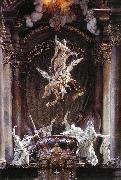 |
ASAM, Egid Quirin
|
|
German Baroque Era Sculptor, 1692-1750
Sculptor, stuccoist, painter and architect, son of Hans Georg Asam. After working with his father, he was apprenticed to Anton Faistenberger in Munich to learn sculpture. He presumably accompanied his brother Cosmas Damian Asam to Rome (1711-13), where he studied works by Bernini. In 1724 he became a valet and court stuccoist to the Prince-Bishop of Freising and in 1730 a valet to the Elector of Bavaria.
|
|
|
|
|
|
 |
Antonio Maria Esquivel
|
|
Nacio en Sevilla en 1806. Comenzo los estudios de pintura en la Academia de Bellas Artes de Sevilla. Alli se familiarizo con la tecnica pictorica y el detallismo al estilo de Murillo.
En 1831, se traslado a Madrid, donde concurso en la Academia de San Fernando, siendo nombrado academico de merito. En contacto con el ambiente intectual madrileno de esos anos, participo activamente en la fundacion del Liceo Artistico y Literario en 1837, donde daria clases de Anatomia, asignatura que impartiria tambien mas tarde en la Academia de San Fernando.
En 1839, otra vez en Sevilla, sufrio una enfermedad que le dejo practicamente ciego; el artista, sumido en una profunda depresion, se intento suicidar arrojandose al rio Guadalquivir. Enterados sus companeros y amigos poetas y artistas y movilizados por el Liceo para ayudarle, sufragaron entre todos un caro tratamiento realizado por un prestigioso oftalmologo frances. Gracias a esto, en 1840 sano y recupero la vision. El artista, agradecido, pinto a sus amigos, poetas y pintores del Romanticismo, en un cuadro que se ha hecho justamente celebre. Como reconocimientos oficiales, recibo la placa del Sitio de Cadiz y la Cruz de Comendador de la Orden de Isabel la Catolica. En 1843 es nombrado Pintor de Camara y en 1847 academico de San Fernando, siendo ademas miembro fundador de la Sociedad Protectora de Bellas Artes. Como teorico de la pintura, redacto un Tratado de Anatomia Pictorica, cuyo original se guarda en el Museo del Prado. Fallecio en Madrid en 1857.
Sus hijos Carlos Maria (1830-1867) y Vicente tambien fueron pintores.
|
|
|
|
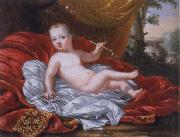 |
Anna Maria Ehrenstrahl
|
|
1666-1729,as married Wattrang, (1666-1729), was Swedish painter, the first female painter in her country. She was a baroque-artist and painted allegorys, portraits and group portraits in the style of the Baroque. Born as child of the court painter David Klocker Ehrenstrahl and Maria Momma, she was instructed as a student by her father to copy and finish his works and to paint details and other such smaller things to complete the paintings in his studio. She is confirmed as her fathers assistant from ca 1680. Her learning as an artist was therefore not complete, as he never intended her to become an independent artist, just as a form of artistic secretary in his studio, but she was in fact to create paintings herself eventually. In 1688 she married Johan Wattrang, vice president in Svea Hovratt, and painted six portraits of this courts former presidents, which she gave the court signed with her own name (1717). Her way of painting was in the same barocque style as her father; she painted allergorys and portraits of both single people and groups, bot real people and mytholocigal figures in the style of the time. Among them was portraits of king Charles XI of Sweden, Prince Ulrik (in 1685), an allegory over the four seasons (1687) and an allegory of Cupid and Psyche. She painted the four king's under her lifetime, the Princes Gustaf and Fredrik, Ulrika Eleonora of Denmark and Aurora Konigsmarck.
|
|
 |
Anna Elizabeth Klumpke
|
|
1856-1942
Anna Elizabeth Klumpke (October 28, 1856?C1942) was American portrait and genre painter born in San Francisco, California, United States. She is perhaps best known for her portraits of famous women including Rosa Bonheur and Elizabeth Cady Stanton (1889).
Her father, John Gerald Klumpke, born in England or Germany , was a successful and wealthy realtor in San Francisco. Her mother was Dorothea Mattilda Tolle. Anna was the eldest of eight children, five of whom lived to maturity. Among her siblings were the astronomer Dorothea Klumpke-Roberts, the violinist Julia Klumpke, and the neurologist Augusta D??jerine-Klumpke.
At age three, Anna fell and suffered a fracture of her femur. She fell again at age five and suffered osteomyelitis with purulent knee arthritis. It handicapped her, and her mother took extraordinary means to remeded the problem by taking Anna and three siblings to Berlin for treatment by Dr. Bernhard von Langenbeck.
The treatments lasted 18 months, including thermal baths at Kreuznach, but unfortunately they were not successful, and she would remained hobbled all her life. While in Europe, her mother ensured that all of her children had excellent tutoring.
The time away in Europe placed a strain on the relationship of her parents. When Anna was fifteen, her parents divorced. She and her siblings (now numbering five) moved with their mother to Göttingen, Germany, where they lived for a time with Mattilda's sister, who had married a German national. Anna and her sister Augusta were sent to school at Cannstatt, near Stuttgart. At age seventeen, the family moved to Clarens, near Lake Geneva in Switzerland where she spent two years in boarding school. She studied art at home for the next few years, and in October 1877, moved with her family once more to Paris, where she was later enrolled in the Julian Academy (1883-1884), under the tutelage of Tony Robert-Fleury and Jules Lefebvre. At one point she also studied under Vuillefroy. She presented her first work at the Paris Salon in 1884, while still at the Academy, and she won the grand prize for outstanding student of the year. She showed regularly at the Salon for several more years.
|
|
 |
Andries van Eertvelt
|
|
1590-1652
Flemish
Andries van Eertvelt Location
Flemish painter. He enrolled as a member of Antwerp Guild of St Luke in 1609. In 1615 he married Catherine Vlieger (d 1627), after whose death he went to Genoa, where he worked for Cornelis de Wael. By c. 1630 he was back in Antwerp, where he had his portrait painted by Anthony van Dyck (1632; Augsburg, Schaezlerpal.). In 1633 Eertvelt married Elisabeth Boots, probably a daughter of the Antwerp painter Jan Boots (b before 1620). Eertvelt is regarded as the first Flemish marine painter. Over the years his palette and style changed. His first paintings, mostly of ships in storms (e.g. Sea Battle in a Storm; Schwerin, Staatl. Mus.), were painted in greenish-black and brown tones, often using white to highlight the rigging against the dark sea. After his tour of Italy he favoured views of southern harbours, with calm seas painted in soft tones (e.g. Spanish Ships Leaving a Port; Vienna, Ksthist. Mus.). In his day Eertvelt was a man of distinction whose artistic qualities were praised by the poet Cornelis de Bie and whose marine paintings were appreciated abroad, some being exported as far as Seville and Lisbon. His pupils included Gaspard van Eyck (1613-73), Hendrik Minderhout (1632-96) and Matthieu van Plattenberg.
|
|
|
|
|
|
|
|
|
|
|
|
|
| Wholesale China Oil Painting Wholesale Oil Painting China Xiamen Portrait Reproduction on canvas Chinese Oil Painting Wholesale USA Oil Painting |
|
|
|
|
|